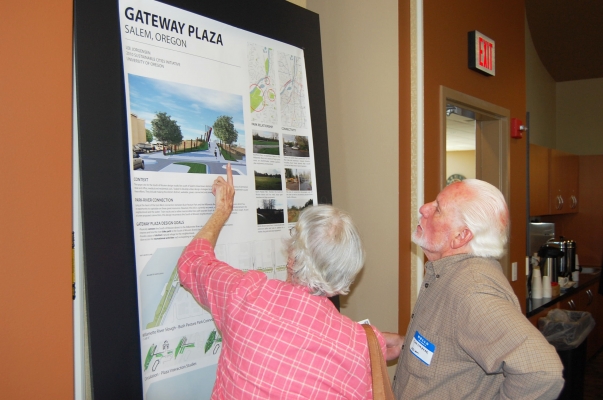Second Sustainable City Year showcases practical, visionary sides in Salem

If the posters lining the wall showed how visionary the Sustainable City Year model can be, the Salem city officials attending the May 20 reception testified how practical it can be as well. The reception recapped the work of the second Sustainable City Year, now drawing to a close.
Sustainable City Year is a program of the Sustainable Cities Initiative, one of three OTREC initiatives. In the program, 500 students on two campuses worked on 16 projects to help Salem meet sustainability goals.
Although work continues in Salem and at the University of Oregon and Portland State University, May 20 was an opportunity to thank the participants and punctuate a second successfully year, following the inaugural efforts in Gresham, Ore. Next year’s Sustainable City Year will focus on Springfield, Ore.
Linda Norris, Salem’s city manager, couldn’t say enough about the contributions the program made to her city. Students in 29 classes on the two campuses put in 80,000 hours of time. Sustainable City Year’s choosing Salem was like magic, Norris said.
The students didn’t just treat their work as a hypothetical problem to solve; they poured themselves into the projects and the goals behind them. “When we heard how seriously they were taking this, and how much they cared about this community, it really did give me goose bumps,” Norris said.
Salem did not have money to get many of the projects started without Sustainable City Year, Norris said. But now that much of the early work has been done, city officials have put money behind the projects, including a new police facility, the pedestrian-and-bicycle network and street lighting.
Salem city traffic engineer Kevin Hottman, said he’s impressed by the enthusiasm of the students. Hottman is working with Christopher Monsere’s Transportation Safety Analysis course at Portland State to rework tricky intersections around town for all road users.
Students in the program bring enthusiasm without the cynicism that can sometimes come with years in a job. “It brings back old memories,” Hottman said, of his engineering education. “They’re less overwhelmed with I have to deal with day to day.”
Cortney Mild, a University of Oregon planning graduate student, worked on projects including the extension of a multi-use path along Mill Creek to connect with and extend the current network. “It’s … great to know our work will have real outcomes,” Mild said, “and add value back to the city of Salem.”
Mild and other first-year planning and architecture students learned quickly how to use their skills and their teammates’ skills to solve real problems. “We were thrown into the pool and had to paddle,” she said.
Asked to design a trail network or a roadway, students in most programs can start with a clean slate. Sustainable City Year students start and end in the real world, Mild said. A seemingly great idea for that roadway, for example, might not meet Oregon Department of Transportation standards. A vision of the trail along Mill Creek might hit buildings built right up to the creek.
“We had to consider what was politically feasible and what was feasible with the land,” Mild said.
Springfield officials were on hand for a glimpse of what they might expect from the program’s next year. But Sustainable Cities Initiative officials have grander ambitions than boosting a third Oregon city: exporting experiential learning to change the nation’s educational system. “It’s a powerful model for how education can work here, in Salem, in Oregon” said initiative Associate Director Nico Larco, “but also for the country.”
